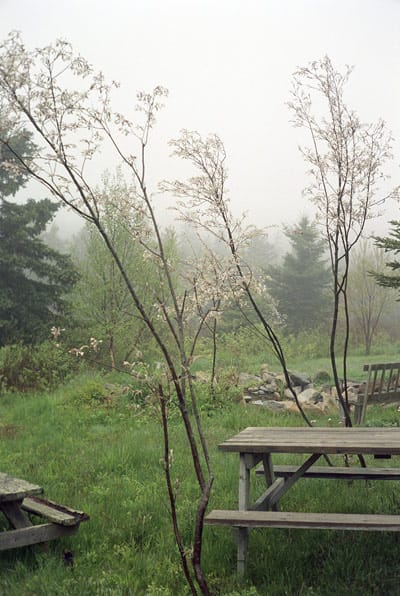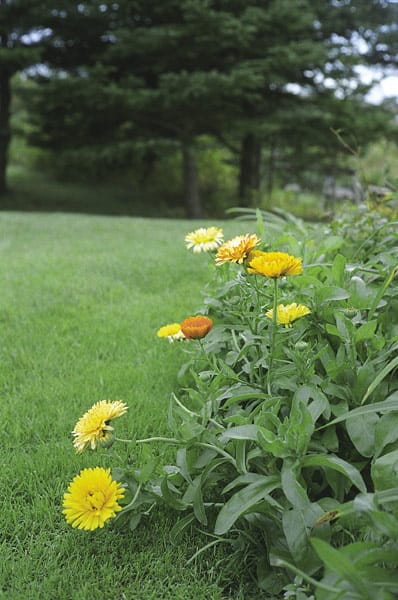The Gardening Urge Hits
The wild garden—a little nurturing, a little nudging, and Mother Nature does the rest.
When we moved to Cow Bay, I knew very little about the coastal landscape. I knew even less about gardening. What I did know was that I had always longed to live in a place like this. Below the hill where we would build our house, a forest of trees stretched south to the Barrier Pond and west across the bog toward Flandrum Hill. We could hear and see the ocean in three directions. Wild rhodora bloomed everywhere.
On excavation day I asked Charlie, our contracter, to save all the pine trees. His deadpan response was a question “Where are your pine trees?” I replied hesitantly, “Well, you know, all the trees that look like Christmas trees.” “You have spruce, and maybe some fir,” Charlie said, “but you don’t have any pine that I can see.”
I had a lot to learn.
In the mid-1900s, our land had been part of a flower farm owned by the late Bertha Conrad. Only recently have I made the startling discovery that Bertha Conrad was the great aunt of my friend Ruth, who taught high school across the hall from me many years ago in a far-off place. It was stranger still that my husband and I bought the property with money I had inherited from my own great aunt, who had also been a flower farmer. The pattern was amazing—two great aunts with flower farms, two grand-nieces who were teachers, a piece of land in Cow Bay, and now I had acquired a longing to become a competent gardener.

As a city kid, I had no experience with horticulture. My family moved from Nova Scotia to Detroit the year before I was born. Our small inner-city backyard contained established plants when we moved in—roses, lilacs, forsythia, hostas, and a Japanese magnolia tree. They all seemed to grow perfectly well on their own, without any help.
Returning to my Roots>
Ten years ago I returned to my Nova Scotia roots, bringing with me my growing family. Our Cow Bay house took shape in a sea of alders, flanked by the grove of spruce trees Charlie had moved and saved. One tiny yellow rose bush blossomed near the excavation site. We saved it in a bucket for replanting after it bloomed, but without the shelter of all those alders it didn’t survive the first winter. One of the many lessons I would have to learn.
We kept this in mind as we cleared away alders, making way for more lasting discoveries. Flowering shrubs and mountain ash seedlings appeared along an ancient rock wall which tumbled down the hillside. Serviceberry, winterberry, chokeberry, willow, rhodora and wild raisin all grew in and around the huge old rocks which had sunk into the ground long ago. We later dug a pond, encircling it with moss-covered rocks from the old farm wall. The slender serviceberry trees, no longer crowded by alders, are now the focal point around the pond and strong enough to grow on their own. Their tasty fruit attracts many birds.
Discovering and identifying what grows naturally in the seaside landscape has been a constant quest. I have learned to search from different vantage points and at different times of year. One June evening after a discouraging day, I looked from a second story window out over the alders and spruce below. To my amazement, I spotted pink apple blossoms, half-hidden by a large spruce tree on the hillside. I ran to clear a new path through the alders. An old wild apple tree had been there all along. What an unexpected joy it was to discover that apple tree.
And there have been more discoveries. The pheasants led us to blackberries ripening on tangled brambles in the alders. We also spied new raspberry canes sprouting at the edge of the backyard where the alders had been cleared but the grass had not been mown. A perfectly-shaped tree appeared in this natural area as well, which we finally identified as a pin cherry.
Observing the Seasons
 The seaside landscape is filled with plants which are growing in the correct soil, the correct sunlight, and the correct amount of shelter from the onshore wind. These native plants also attract, feed, and shelter wildlife. We look forward to the creatures that fill our yard now in almost every season—mourning doves, chickadees, blue jays, sparrows, deer, foxes, porcupines, red squirrels, toads, snakes, and the pheasants who strut around Cow Bay as though they own the place. Our yard is also host to many interesting insects and to the garden spiders who, every summer evening, spin new and perfect webs that greet us with dewy symmetry in the morning light across our windows.
The seaside landscape is filled with plants which are growing in the correct soil, the correct sunlight, and the correct amount of shelter from the onshore wind. These native plants also attract, feed, and shelter wildlife. We look forward to the creatures that fill our yard now in almost every season—mourning doves, chickadees, blue jays, sparrows, deer, foxes, porcupines, red squirrels, toads, snakes, and the pheasants who strut around Cow Bay as though they own the place. Our yard is also host to many interesting insects and to the garden spiders who, every summer evening, spin new and perfect webs that greet us with dewy symmetry in the morning light across our windows.
I also look forward to the progression of wildflowers which pattern the landscape from spring to fall each year: There are blue flags, daisies, wild roses, thistles, evening primroses, goldenrod and asters. Together they provide a template for perennial gardening. Several years ago we planted wild lupins in our ditch. They have spread in both directions, filling foggy June with brilliant colour and a peppery scent.
Some wildflowers can be trouble though, if they get into the garden. One of our perennial gardens is a large circle in the middle of the front lawn, created by necessity when we ran out of sod that first October. Seven years passed before the circle looked “filled in,” and once or twice the garden had to be completely reconstructed because of unwanted invaders. I hadn’t recognized the danger of creeping buttercups until they had wound their way through everything in the garden. Purple vetch is another vine-like weed for which I am now on guard.
Learning from mistakes
In those early years there was much I needed to learn about flower gardening. The first lesson was the difference between perennials and annuals. Then I had to differentiate between acidic and alkaline soil as well as understand that only certain plants would survive in our acidic, clay-based soil, and how to enrich the soil with compost. Finally, I discovered which plants were hardy enough to withstand the strong northeast wind, the salt spray, and the freeze-thaw pattern of many recent winters. Most of this knowledge has been acquired by observation (Cow Bay is filled with fantastic gardeners) and reading, and by the process of trial and many errors.
The perennials, which have survived and prospered here, include irises, geums, coral bells, pinks, shasta daisies, hardy geraniums, anthemis, daylilies, and hardy lilies (although they aren’t looking too “hardy” these past two summers). These plants bloom in June and July. In August, the hostas, astilbe, creeping thyme, rudbeckia, echinacea, phlox, and sedum begin to bloom. Some of these plants grow in full sun; some grow best in half-day sun. Some spread more aggressively than others—like rudbeckia and anthemis—but are worth the extra effort because they consistently produce many long-lasting blooms.
I don’t plant many annuals, but have fallen in love with the calendula because it thrives in cool weather and blooms faithfully until Remembrance Day each year. When everything else is finished in the garden and the November landscape has changed to browns and greys, this vivid orange flower still brightens the front of the property.
The Garden Journal as Recordkeeper
A journal has become one of my most important gardening “tools.” It helps me recollect what grew well, the bloom periods of the various plants, and in my planning for the following season. (If I don’t write it down, it gets forgotten over the winter.) This gardening journal is also a place to note that many of our plants were kind donations from friends’ gardens, or a meaningful gift from someone special.
One year, our hydrangea didn’t bloom at all. Then I read that hydrangea prefer sweet soil. Now I spread pelletized limestone around its base each spring when I am liming the grass and, in gratitude, it faithfully produces large, cream-coloured flowers. I also lime the lilac, the forsythia, and the soil where I plant calendula seeds each spring.
Our lilac bush didn’t bloom for many years. We moved it at least three times, seeking a better location for it to grow. Finally, we found a sheltered, sunny spot and left it there—still no blooms. Only after six years of waiting did it produce three gorgeous, fragrant blossoms. I had learned another important lesson: some plants need plenty of sun and shelter, but they also need to stay in the same place for a while.
We have been in Cow Bay now for 10 years, watching the spruce trees grow tall and the garden grow full. Time is an important ingredient—for a garden, for a home, and for making new discoveries.
There is still much to learn. I plan to continue searching in the alders for the gifts nature provides for free.
